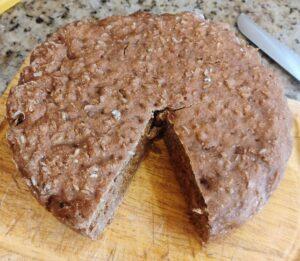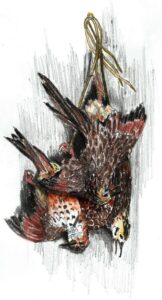Taste the Fourteenth Century
Our 1300’s lad has had quite a day! Wee Laird John’s pride has earned him discipline and he is still being humbled. But humble fare is hardly horrid! I think you will savor his Black Bread as much as we did! And, don’t feel too sorry for John. His Aunt Edith has a real soft spot for her dead sister’s boy. She slips him some dessert — Ryshews of Fruit – a kind of fritter. Yum!
Black Bread (Medieval Rye)
Ingredients
- 400g rye flour
- 100g barley flour *
- 400g water
- 3 tbsp malted barley syrup (or substitute molasses)
- 1/4 cup sourdough starter (or substitute 1/2 tsp dry yeast)
- 1/2 cup whole rye berries
- 1/2 cup pressed oats
- 2 tbsp fennel seed
- 2 tsp salt
*(Note: For a slightly more noble experience, substitute the barley flour with whole wheat for a lighter bread more befitting your Lairdship.)
Directions
- Start by boiling some water and pouring it over the whole rye berries. Let steep for one hour, then drain. Meanwhile, mix all the flours, seeds, and salt together.
- Make a well and pour in the water, stirring in the molasses without mixing much flour in. Then stir in the starter or, if using yeast, sprinkle it on top of the liquid. Stir everything (including drained rye berries) together with a wooden spoon until no dry flour remains.
- Cover and let rest for 15 minutes. Stir again. Cover and rest another 15 minutes, then stir and cover it one more time. It will be very sticky and formless. That’s okay.
- Now cover, sit in a warmish room temperature place, and let the dough ferment for 12-24 hours. The longer you proof, the more sour the eventual flavor.
- Whenever you’re finished with the long proofing period, scrape the wet dough onto a heavily floured surface (using regular All Purpose Flour works fine here). Flour your hands and shape the dough into a round loaf. Cover with the bowl and let it proof for one more hour.
- Don’t worry if the loaf doesn’t rise much. It won’t. That’s just how near wheatless loaves go. It will get a bit of spring in the oven, but not that much.
- Preheat the oven to 475F for a good 30 minutes before use, as well as whatever vessel you’re cooking it in. Any iron or ceramic cookware will work, though something with a lid works best.
- Dust the loaf and a knife with flour and score the bread. Generously flour the bottom of the preheated baking vessel and gently set the bread inside. Close the vessel and cook for 20 minutes. Remove the lid, and bake another 15-20 minutes, until dark and crispy, and the internal temperature is about 200F.
- Let cool completely before slicing.

Notes
I thought this bread would be unpleasant, but it turned out delicious. The tangy sourdough and spice from the fennel make for a strong, unique flavor. Its heartiness makes for a great sop to mop up soups, stews, or the juices of an herb-stuffed roasted chicken. Serve it up with a rustic whole-grain mustard too. Yum. Now that is what I call a delicious Medieval meal.
Find the whole and original recipe at ANTHROCHEF
Are you wanting a slightly less delicious shortcut and willing to be less historically accurate? Sink your teeth into John’s loaf quicker with this bread machine version.

Ryshews of Fruit (Fritters)
This recipe is from the Forme of Cury, a 14th-century English manuscript.
Ingredients
- 1/2 cup raisins
- 1/2 cup dried figs
- Red wine (*if no adult is helping see note below)
- 2 small apples
- 1 large pear
- 1/4 tsp each of ginger, cinnamon, nutmeg
- 1/8 tsp cloves
- 2 Tbs white sugar
- 3-5 Tbs white flour
Directions
- Chop the raisins and figs fine using kitchen scissors. Pour red wine over the dried fruit and let it sit for at least an hour.
- Combine ginger, cinnamon, nutmeg, cloves, and sugar. Set aside.
- Peel the apples and pears, and chop them fine. Grind the apples and pears using a mortar and pestle, or a blender/food processor.
- Grind the raisin and fig mixture with the apple and pear mash. Drain the fruit, discarding the wine (or save it for other projects). Add the soaked dried fruit to the mashed apple and pear, ensuring the fruit mixture is well mixed and not extremely lumpy.
- Add the spice mixture to the fruit mixture, along with 3-5 Tbs of white flour, depending on the juice content. The mixture should be sticky enough to roll into balls.
- Roll the mixture into balls about 1 inch in diameter, then roll each in white flour. Set aside while you heat up the oil.
- In a heavy-bottomed pan, heat vegetable oil to a depth of about 1.5 inches on medium heat until hot but not smoking. Test the oil by sprinkling a tiny amount of water; it should sizzle sharply.
- Put each fruit ball in individually, ensuring the oil sizzles with each addition. Fry in small batches to keep the oil temperature consistent. Cook for approximately one minute until golden brown on the outside and soft and tender on the inside. Drain the fritters well before serving.
*You can substitute red wine in recipes with red wine vinegar, apple cider vinegar, red grape juice, cranberry juice, or pomegranate juice.
Enjoy making and savoring these historical fritters from Totalwingnut’s Blog!
They redacted the recipe from the Forme of Cury , a King’s Cookbook from the period. A full copy is available online.
